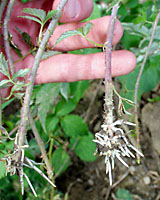Terry L. Ettinger Horticulture Consulting Services
Meeting The Needs Of Today With A Vision For The Future
Question of the Week
Pruning Raspberries
 Q. I've learned a lot from your radio and TV shows over the years! However, there's one topic about which I
remain very confused, even though you've discussed it numerous times. It's about when and how to prune red (Titan, Canby and
Heritage) and black (Jewel) raspberries? We planted fifty of each of these plants this past spring and look forward to
making a lot of pies in the future - if we can figure out how to prune them?
Q. I've learned a lot from your radio and TV shows over the years! However, there's one topic about which I
remain very confused, even though you've discussed it numerous times. It's about when and how to prune red (Titan, Canby and
Heritage) and black (Jewel) raspberries? We planted fifty of each of these plants this past spring and look forward to
making a lot of pies in the future - if we can figure out how to prune them?
A. Wow! Two hundred raspberry plants, if they're grown well, can yield between one and one and one-half pounds of fruit per plant each year. This means that you might end up picking more than 200 pounds of raspberries every year - which translates into a lot of pies!
Dissecting your list of raspberries reveals three distinct growth habits: summer-bearing red raspberries (`Titan' and `Canby'), ever-bearing red raspberries (`Heritage') and summer-bearing black raspberries (`Jewel').
The easiest of the four varieties to prune are the `Heritage' red raspberries. Simply mow or cut them back to a height of three to four inches every spring before new growth begins. As with all "ever-bearing" red and yellow raspberries, your `Heritage' raspberries will then send up a flush of new shoots as the weather warms, then bear fruit on these shoots in August and September.
Summer-bearing red raspberries, meanwhile, require a little more effort because they bear their fruit on one year old canes.
The first step is to cut the canes that bear fruit (these are called "floricanes") right back down to the ground as soon as the harvest is complete in July or early August. Next, during the first stretch of nice weather the following February or March you'll want to thin out the remaining canes so that there are no more than six to eight vigorous, large-diameter canes per foot of row. Finally, cut back the tops of these canes to a height of between four and five feet from the ground - which is a fairly comfortable height at which to harvest the fruit as they ripen in July.
Highest on the list of raspberry pruning complexity is your `Jewel' black raspberries.
As with summer-bearing red raspberries, cut the spent floricanes of black raspberries right back to the ground as soon as you've picked the last fruit from them in late June through mid-July.
 You'll also want to top the current season's new, vigorous shoots (called "primocanes") at a height of between
three and four feet as needed throughout rest of the summer. This "topping" procedure will prevent the tips of the young primocanes
from flopping over and taking root all over the place, at left. It will also trigger the formation of side shoots along the length
of the new primocanes from which fruit will be borne the following summer.
You'll also want to top the current season's new, vigorous shoots (called "primocanes") at a height of between
three and four feet as needed throughout rest of the summer. This "topping" procedure will prevent the tips of the young primocanes
from flopping over and taking root all over the place, at left. It will also trigger the formation of side shoots along the length
of the new primocanes from which fruit will be borne the following summer.
Finally, in February or March thin out your black raspberries to no more than five to ten strong, thick canes per crown and shorten the side shoots that formed the previous summer to roughly four to eight inches in length.